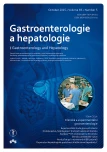-
Medical journals
- Career
First experience with digital Spyglass™ DS in Slovakia from the gastroenterology department of the Trnava University Hospital
Authors: R. Husťak 1,2; J. Ušák 1; D. Kudlová 1; A. Klepanec 3; F. Závada 1,4; J. Martínek 1,5
Authors‘ workplace: Gastroenterologická a endoskopická ambulancia, Interná klinika FZSP TU a FN Trnava, Slovenská republika 1; 1. LF UK v Praze 2; Rádiologická klinika, FZSP TU a FN Trnava, Slovenská republika 3; Gastroenterologie, Oblastní nemocnice Příbram, a. s. 4; Klinika hepatogastroenterologie, Transplantcentrum, IKEM, Praha 5
Published in: Gastroent Hepatol 2015; 69(5): 418-423
Category: Clinical and Experimental Gastroenterology: Original Article
doi: https://doi.org/10.14735/amgh2015418Overview
The diagnosis of biliary strictures remains challenging, and it can be difficult to differentiate between benign and malignant strictures. Cholangiography characteristics alone obtained during ERCP or MRCP may not be specific enough to indicate unambiguous decisions on patient management. Peroral choledochoscopy can improve the diagnosis of indeterminate strictures by visualisation of the mucosa at the stricture site and enables obtaining directed biopsies in order to increase the diagnostic yield. Cholangioscopy options have been limited so far. Some workplaces, including our department in Trnava, worked with the first generation cholangioscopy (SpyGlass®), which was based on the fibre-optic principle and image quality was not perfect. Therapeutic interventions and taking biopsy specimens was also difficult with the first generation SpyGlass®. The new system working on principle of a digital imaging (Spyglass™ DS) is characterized by improved image quality, which is incomparably better compared to the first generation, taking biopsies seems to be easier as well. The image quality is higher compared to the first generation and taking biopsies also seems to be easier. In this article we summarise our first experience with the new SpyGlass™ DS.
Key words:
cholangioscopy SpyGlass™ DS – biliary stenosis – endoscopic retrograde cholangiopancreatography
The authors declare they have no potential conflicts of interest concerning drugs, products, or services used in the study.
The Editorial Board declares that the manuscript met the ICMJE „uniform requirements“ for biomedical papers.Submitted:
17. 8. 2015Accepted:
6. 10. 2015
Sources
1. Chen YK, Pleskow DK. SpyGlass single-operator peroral cholangiopancreatoscopy system for the diagnosis and therapy of bile-duct disorders: a clinical feasibility study (with video). Gastrointest Endosc 2007; 65(6): 832–841.
2. Victor DW, Sherman S, Karakan T et al. Current endoscopic approach to indeterminate biliary strictures. World J Gastroenterol 2012; 18(43): 6197–6205. doi: 10.3748/wjg.v18.i43.6197.
3. Husťak R, Ušák J, Kudlová D et al. Prvé skúsenosti so single-operator perorálnou cholangioskopiou (SpyGlass) na Slovensku. Výsledky z gastroenterologického pracoviska FN Trnava. Gastroenterologie a hepatologie 2015; 69(3): 219. doi:10.14735/amgh2015211.
4. Keane MG, Marlow NJ, Pereira SP. Novel endoscopic approaches in the diagnosis and management of biliary strictures. F1000Prime Rep 2013; 5 : 38. doi: 10.12703/P5-38.
5. Tringali A, Lemmers A, Meves V et al. Intraductal biliopancreatic imaging: European Society of Gastrointestinal Endoscopy (ESGE) technology review. Endoscopy 2015; 47(8): 739–753. doi: 10.1055/s-0034-1392584.
6. Nishikawa T, Tsuyuguchi T, Sakai Y et al. Preoperative assessment of longitudinal extension of cholangiocarcinoma with peroral video-cholangioscopy: a prospective study. Dig Endosc 2014; 26(3): 450–457. doi: 10.1111/den.12159.
7. Urban O, Arnelo U, Klíment M et al. Cholangiopankreatoskopie pomocí Spyglass direct visualisation system: seznámení s metodou a první vlastní zkušenosti. Gastroenterol Hepatol 2013; 67(2): 124–126.
8. Keegan JM, Singh R, Lim P et al. Which optical features differentiate benign and neoplastic biliary lesions as assessed by balloon assisted cholangioscopy? Gastrointest Endosc 2015; 81 (Suppl 5): 78. doi: 10.1016/j.gie.2015.03.1284.
9. Sethi A, Shah RJ, Itoi T et al. Defining imaging criteria for indeterminate biliary strictures utilizing video cholangioscopy: the Monaco classification. Gastrointest Endosc 2015; 81(Suppl 5): 188–189. doi: 10.1016/j.gie.2015.03.1939.
10. Itoi T, Kamisawa T, Igarashi Y et al. The role of peroral video cholangioscopy in patients with IgG4-related sclerosing cholangitis. J Gastroenterol 2013; 48(4): 504–514. doi: 10.1007/s00535-012-0652-6.
11. Osanai M, Itoi T, Igarashi Y et al. Peroral video cholangioscopy to evaluate indeterminate bile duct lesions and preoperative mucosal cancerous extension: a prospective multicenter study. Endoscopy 2013; 45(8): 635–642. doi: 10.1055/s-0032-1326631.
12. Chen YK, Parsi MA, Binmoeller KF et al. Single-operator cholangioscopy in patients requiring evaluation of bile duct disease or therapy of biliary stones (with videos). Gastrointest Endosc 2011; 74(4): 805–814. doi: 10.1016/j.gie.2011.04.016.
Labels
Paediatric gastroenterology Gastroenterology and hepatology Surgery
Article was published inGastroenterology and Hepatology

2015 Issue 5-
All articles in this issue
-
XXIXth Hildebrand Bardejov gastroenterology days
Inflammatory diseases in case reports and well-arranged lectures - The selection from international journals
- Leaving
- A pilot experimental study of oesophageal stenosis after ESD
- Variable endoscopic appearance of early squamous cell carcinoma of the oesophagus
- First experience with digital Spyglass™ DS in Slovakia from the gastroenterology department of the Trnava University Hospital
- Endoscopic histologisation of diminutive colorectal polyps. Are we ready for a change?
- Quality of biopsies in patients with Barrett’s esophagus – jumbo vs. large capacity forceps
- Screening colonoscopy among elderly patients over 70 years
- Home parenteral nutrition – its importance and use in clinical practice
- Standard diagnostic and therapeutic approaches to chronic hepatitis C virus infection
- Ledipasvir/ sofosbuvir – rapid development of knowledge reduces treatment time
- Hands-on training of advanced endoscopic methods – an international workshop in Athens
- New approaches in the follow-up of patients suffering from inflammatory bowel diseases
-
XXIXth Hildebrand Bardejov gastroenterology days
- Gastroenterology and Hepatology
- Journal archive
- Current issue
- Online only
- About the journal
Most read in this issue- Endoscopic histologisation of diminutive colorectal polyps. Are we ready for a change?
- Screening colonoscopy among elderly patients over 70 years
- Home parenteral nutrition – its importance and use in clinical practice
- First experience with digital Spyglass™ DS in Slovakia from the gastroenterology department of the Trnava University Hospital
Login#ADS_BOTTOM_SCRIPTS#Forgotten passwordEnter the email address that you registered with. We will send you instructions on how to set a new password.
- Career

